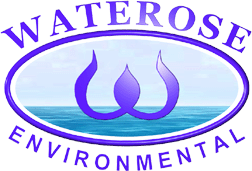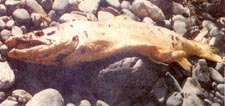 | ||||||
| Articles | Projects | Resume | Cartoons | Windsurfing | Paintings | Album |
Sooke River Watershed Twelve Month Baseline Water Quality Study for Salmonids 2000
Reading the Sooke River's pulse...offers clues to future of salmon
by G.E. Mortimore, Victoria Times Colonist Enviro News February 2000

Waterose Environmental Services
Vancouver Island, BC


Environmental Scientist Judith Burke draws the last of the water samples from the Sooke River and heads home at noon. She is taking the measurements of the river at a critical time - when far-reaching development is about to change the face of the Sooke watershed.
Some days Judith eats lunch; but not today when she makes an immediate restart on the job that has filled her thoughts for nine years - measuring what's in the water. She spends six hours testing, calculating and entering numbers on computer spreadsheets.
In her kitchen laboratory, test tubes and electronic gear occupy more space than saucepans and groceries. Two smart gadgets slightly bigger than TV channel-changers - a colorimeter and a digital titrator - help her gauge each sample for the micropresence of substances ranging from cyanide to wood-fibre lignin.
Using a door salvaged from the dump as a table, she takes an hour to prepare for tomorrow's testing. She sterilizes bottles, brings together chemical reagents for on-site tests and packs the scientific tackle into two Canadian Tire tool chests and a plastic bin.
Her 12-month project includes measuring flow rates, dissolved gases, metals, sand in the water and nutrients for the food chain of the salmon. Other scientists had studied Sooke basin and the river's source where Victoria's [drinking] water comes from; but the lower river was a near-blank on the scientific map until Judith wrote a research proposal which drew a $22,000 grant from BC Fisheries Renewal, BC.
At a time when Sooke is taking off into rapid commercial and residential growth, Judith's water-quality numbers may be likened to the readings on the cockpit dials of a jetliner. They will show where Sooke was when the takeoff began, and how swiftly the district is flying away from its rural past.
The river and sea-basin ecosystem is a central fact of Sooke's tourist trade and a naturescape treasure for the region. The baseline scientific profile will give knowledge to policy-makers, before the startup of the Deertrail Resort on the Sooke Potholes and the expansion of the Sooke Reservoir. It will warn of hazards.
On October 24, Judith piggybacks a visitor child through shallows where salmon are splashing. Water in a tributary is too low for chum and coho to run. She points to debris stuck high in the bushes; that's the last flood level. After November rains, torrents roar downriver. Judy accidentally falls in, scrambles out and gets back water-sampling.
 Old-timers tell her of a decline in salmon. Loggers confess their sins. They have logged steep slopes, cleared trees to the water's edge, reduced the capacity of the land to absorb rainwater. They have caused floods, erosion, and silting. They promise not to do it again. Judy returns to the lab in her wetsuit. She is here to measure, not to accuse.
Old-timers tell her of a decline in salmon. Loggers confess their sins. They have logged steep slopes, cleared trees to the water's edge, reduced the capacity of the land to absorb rainwater. They have caused floods, erosion, and silting. They promise not to do it again. Judy returns to the lab in her wetsuit. She is here to measure, not to accuse.
A remarkable journey brought her to this point. At age 30, she abandoned a successful career as a customs broker, because money-chasing and status display felt futile after the deaths within six months of her father, grandmother and her dog. Dreams of water, animals and trees had run through her mind since she had flown with her bush-pilot father and sat beside her grandfather watching TV and hoping she would grow up to be like Jacques Cousteau.
She gave her trendy furniture to women's shelters and her blue fox fur coat to her mother, and spent the next eight years on high school makeup and at Langara College and Royal Roads University, earning a B.Sc.
She nearly quit the new career before it started. Research and conservation money had dried up because of hard times. She couldn't get a job. She was ready to leave town. For three months she was on social assistance. "I gave up on getting a normal job. I decided to do what I wanted to do. I found the closest local environmental group and volunteered."
She became Sooke's recycling co-ordinator and a helper in the Jack Brooks hatchery. Then the volunteer network brough news of funding available through Fisheries Renewal BC. Some research money was on the offer. It came as a happy surprise to Judith when her research proposal was accepted; but she wasn't yet ready to go ahead, because the enterprise called for some heavy-duty professional equipment she didn't possess. The problem solved itself when she received a well-timed payout of $10,000, her share in the sale of a family cottage. She spent it to buy the scientific gear.
Since August, she has been testing two sites on the river and one on DeMamiel Creek, which drains much of the residential, commercial and agricultural Sooke. On four days a week she continues the volunteer labour that opened her career gateway.
"I'm not an environmentalist. I'm an environmental scientist," she says. She has nothing against people who chain themselves to trees, but that isn't her game. She deals in facts, at the scientific and popular levels. Her self-designed 10 megabyte Web site receives a minimum of 1000 visitors per week. It contains everything she has studied and researched, plus the whimsical cartoons she draws, featuring talking fish and worms, and her own dark serious paintings of research places.
Judith's water quality numbers point toward future salmon, crabs, oysters, eagles and money in the bank for Sooke - not necessarily for her.
"We have everything we need," she says. She means the estimated total of $5 an hour that the project pays her and her cocker spaniel Copper, who goes with her to the riverside and aboard her canoe during pleasure journeys.
"See those piles of white?" she says, sitting on a Sooke Basin waterfront bench with feet propped up on the canoe. "Those are oyster shells. But they can't harvest oysters here because of the fecal coliform. They bring them in from Fanny Bay.
We paddle everywhere. We watch marine animals, the vegetation and the seasons. At Christmas, my idea of a good day is to go for a long paddle."
Other Water Quality Projects by Waterose:
Research and Development Automated Water Quality Monitoring Project on the Sooke River
Testing the Waters
Story in Sooke News Mirror, March 28, 2001 about the Automated Water Quality Monitoring ProjectTwelve Month Baseline Water Quality Study for Salmonids in the lower Sooke River Watershed (Victoria Times Colonist Enviro News)
Twelve Month Baseline Water Quality Study for Salmonids in the lower Sooke River Watershed (Sooke Mirror)
Twelve Month Baseline Water Quality Study for Salmonids in the lower Sooke River Watershed Final Report by Waterose
Water Quality Project on Musqueam Salmon Stream in Urban Vancouver
Analysis of Coliforms and Nutrients in surface waters flowing into Esquimalt Lagoon
Water Quality Monitoring on Ayum Creek, a wild salmon and trout bearing stream, for Society for the Protection of Ayum Creek and Fisheries and Oceans, Canada


 email Waterose
email Waterose
Please Sign My Guestbook
Please View My Guestbook

| Articles | Projects | Resume | Cartoons | Windsurfing | Paintings | Album |
 | ||||||